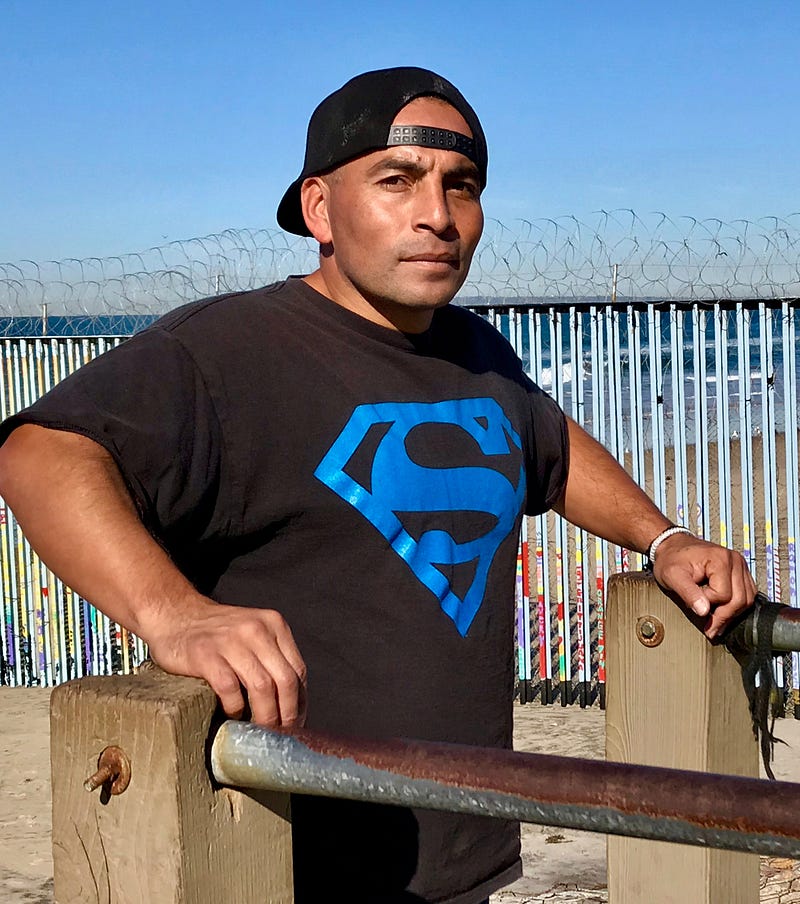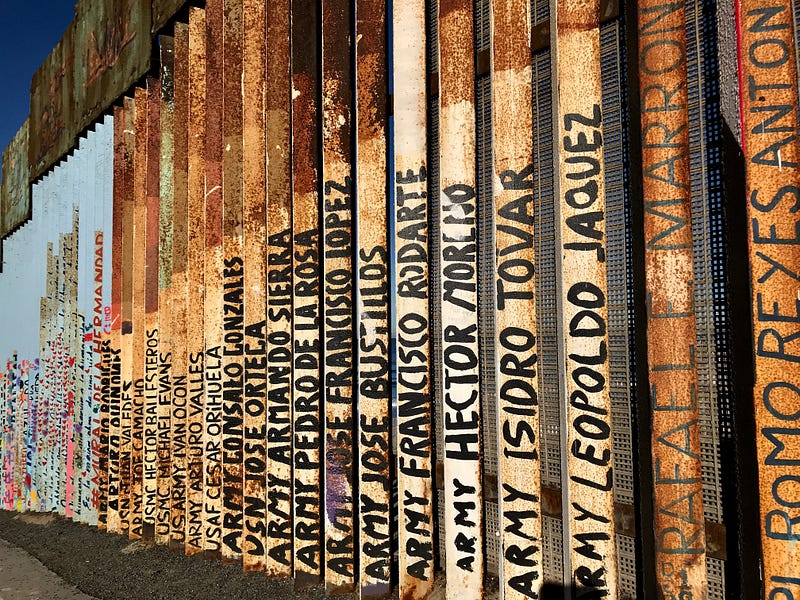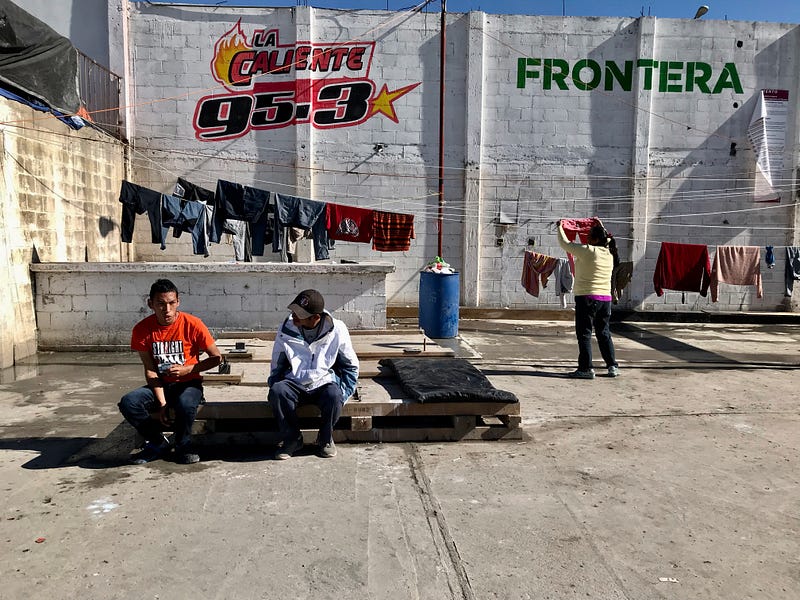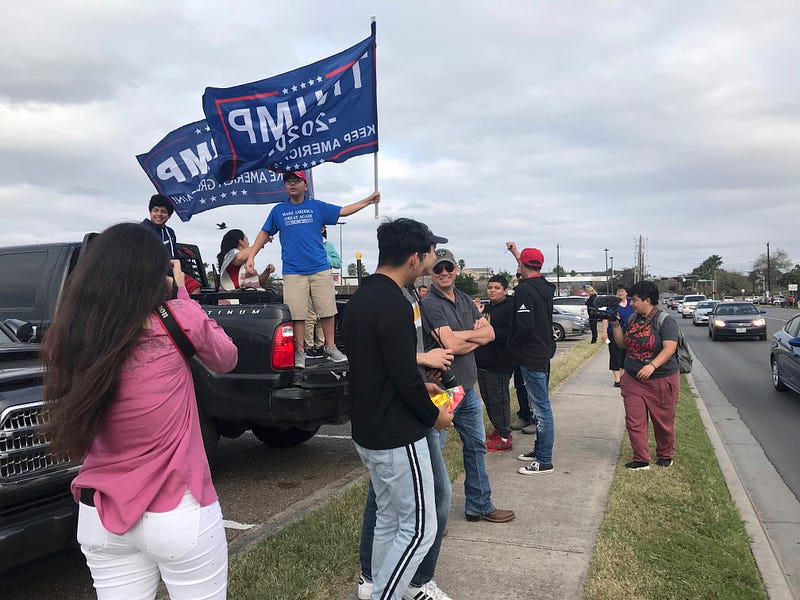
Find the cost of Freedom
Buried in the ground.
Mother Earth will swallow you,
Lay your body down.
-Crosby, Stills, Nash & Young
So what the hell is going on down at the border, and why this exodus of hundreds of thousands of people risking everything for a shot at “freedom” in the United States?
Bold questions. I sought answers.
For me, January of 2019 started off with an eye-opening bang when I took a road trip along the notorious Mexican-American border. I photographed the migrant camps in Tijuana, stood vigil at the Paso Del Norte Port of Entry in Ciudad de Juarez while my colleague, Myron, was detained and abused by U.S. border patrol, and interviewed flag-waving Mexican Americans stumping for Trump in McAllen, Texas.
The trip was alternatingly surreal and heartbreaking, and the complexity of the immigration conundrum became painfully clear. The journey demonstrated America’s rapid descent into an explosive array of human rights abuses.
At the walls bordering California and Texas, divisive altercations over Trump’s immigration policies are disastrously affecting migrant asylum seekers running for their lives from failed regimes in El Salvador, Honduras, Guatemala and Nicaragua.
Historically, one need only look back at decades of botched U.S. foreign incursions in the region, dating back to the CIA’s covert operation to overthrow Guatemala’s democratically elected president in 1954.
Protecting Central American elites, American business interests (especially the United Fruit Company) and autocratic dictators plunged those countries into economic chaos.
U.S.-backed forces trained the military elites to crush worker-led movements to unionize. Over 200,000 people in Guatemala alone were murdered. Poverty reigned over these countries, and fueled the proliferation of drug cartels and gangs like MS-13 and the 18th Street gang.
Time and again, indigenous people were the primary victims of genocidal atrocities.
Human rights violations are being exposed, often with the aid of social media, and stoking the world’s consciousness. Independent activists, lawyers and non-profit organizations are flocking to the border to help families trapped in limbo in Mexico or incarcerated in dog cages and detention camps on the American side.
These facilities have reports of sexually abusive guards, untreated illnesses and children forcibly separated from their parents, not to mention several minors’ deaths.
In Tijuana, “Water Protectors” from Standing Rock and a slew of young people from the U.S. secretly lived in a safe house at Playa de Tijuana, located a few blocks from the border wall.
One can see the border from the beach where it begins a quarter of a mile into the ocean, and follow the walls out over a hill until it disappears into the desert. Here there are two parallel walls; in between is no man’s land.
Standing in Mexico, one can peer through the vertical steel grids of the barricade and see San Diego sparkling on the other side.
A rainbow of dancing butterflies, blooming flowers, and names of forgotten and deported Mexican soldiers who served in the U.S. military are painted on the Tijuana side of the wall.
The messages echo the broken dreams and living nightmares of the migrants seeking asylum in the United States.
Escape to the “Promised land” is a dream you can see, but you cannot touch.
Beyond these colorful messages of hope, cutout cardboard effigies of children lay collapsed against the barbed wire.
In the last decade, more and more previously incarcerated Mexican men, with Green Cards and families in the U.S., were deported to Mexico upon release from prison. They were sent to a country they do not know.
Ricardo Ramirez had paid his debt to society, and had lived his entire life in the States. He has no family in Mexico, and he doesn’t speak Spanish. Every morning, he shows up to work out in the outdoor seaside gym next to the wall, hoping exercise will stem the tides of isolating depression.
Around 10 p.m. on New Years’ Eve in 2018, about a hundred Central American migrants brazenly climbed a hill in an unprotected area of the wall. Mothers scampered up with their babies on their backs, scaling the razor wire fence to freedom. Humanitarian activists pushed the families over the top, where they were immediately arrested and taken into custody.
Pandemonium erupted on that starry New Year’s night, as U.S. border patrol, the Mexican military and helicopters swarmed the area. The hill was soon engulfed in trails of smoke from exploding tear gas canisters and screaming people…
One over-zealous but well-meaning American demonstrator ripped a gas mask off the face of a Palestinian journalist working for the Washington Post and gave it to a mother choking on gas.

The next day was New Years 2019, and the sun was out in Tijuana. The waves on the ocean were calm. The sky was a vibrant blue. The boardwalk leading to the wall was dotted with cafes and pizza parlors. It was quiet, but not for long.
I visited two huge migrant camps set up after the Benito Juarez neighborhood of Tijuana was raided by Mexican law enforcement.
Several hundred asylum seekers stayed in a nearby unlit and unheated warehouse. Every day, a volunteer organization delivered meals to the indigent people.
A few days after that, the Tijuana city administration stopped picking up garbage. Overflowing Port-a-Potties stopped being serviced. On Jan. 4, the warehouse was raided at 3 a.m. by the authorities citing the facility as a health hazard.
El Barretal was the other encampment, established in a concrete open–air sports structure and complete with bathrooms, showers and a space for commerce and a little bit of soccer. Armed forces surrounded the facility.
Tents were squeezed together like Rayon condos on top of packing crates tightly nestled under huge tarps strung together with rope.
The camp was full of vibrant voices and sound making the most of a stressful situation. Self-appointed sanitation workers kept the place clean. Women hung up laundry on the clotheslines to dry. Small-time cigarette salesmen, hardcore card-playing groups, soccer games, blaring Mexican rap music, and people lined up to rummage through the clothes and shoe donations formed the chaotic scene.

Most of the people at El Barretal were young men escaping Honduras. Workers were running from jobs where employers failed to pay them for their back-breaking labor.
Several of the men I spoke to ran a finger across their jugular, like a sharp knife, to illustrate their fate if they pushed for payment or failed to work for the cartels or join a gang.
Random killings and violent home invasions in Honduras are commonplace and typically are not investigated. Law enforcement takes their directives from rich landowners, and environmentalists are frequent targets of assassination who dare to challenge them.
Reports have surfaced recently of women in Honduras being dismembered, beheaded and skinned alive for refusing to work as drug mules.
And making it to Tijuana is no guarantee of safety. Two unaccompanied male minors escaping the brutality in Honduras were kidnapped by the drug cartel that controls the border town. Their bodies were found murdered a few days after Christmas.
The second phase of the trip included a visit to Ciudad de Juarez, the city infamous for the unsolved rape, torture and murders of hundreds of impoverished and factory-working young women.
My colleague Myron and I strolled across the bridge linking El Paso with Ciudad de Juarez. We had our iPhones out when we crossed back into the safe haven of the United States…or so we thought.
I was questioned and casually waved over to the luggage detector. Myron used his Paiute Tribal ID as identification, the same form of ID that easily got him through the border in Tijuana.
I helplessly stood by as Myron was hauled off to a back room by U.S. border patrol agents. He was detained, interrogated and handcuffed to a chair, for his “own safety,” for over nine hours. This incarceration happened on the American side.
Deception, coercion and psychological battering tactics were used by border patrol, and they used their interpretation of the Patriotic Act as a justification for the abuse.

Myron, a pillar of journalistic integrity from Standing Rock, answered every question with a historical reference from an indigenous point of view. This did not stop the authorities from illegally confiscating, searching and seizing his phone without a warrant in a gross violation of journalists’ rights protected under the First Amendment.
Meanwhile, I’m outside in the freezing cold in the middle of the night, provided with no information and threatened with being forcibly removed from the premises or arrested for making inquiries.
I was alone in the dark in a seedy part of town and was repeatedly told it would only be 15 more minutes until my friend would be released. It was nine hours.
I contacted a lawyer from the Standing Rock Legal Collective for help. The phone in the detention area just rang and rang when she called. We got a bitter dose of what asylum-seeking migrant families must go through — no information, illegal kidnapping and forced separation.
Myron witnessed mothers and children lying sick on the floor, with fevers of up to 105 degrees while he was being detained. No one was offered medical assistance.
He witnessed vulgar and degrading interrogations of migrant mothers, and had to sit through one himself. The interrogator asked Myron if he had ever witnessed any kidnappings (in Mexico). Myron, who is a historical trauma counselor, took this opportunity to educate the ignorant.
“Yes. Native Americans have survived over 500 years of genocide, the relocation act, terrorism in the residential boarding school system and legalized kidnapping of our children by the U.S. government and faith-based organizations,” he said.
The following morning, at 2:30 a.m., he was released, albeit without his phone. I was waiting for him.
The third phase of the trip landed us in McAllen, Texas, during Trump’s propaganda border wall trip. Air Force One was taxiing down the runway, while about 50 people, mostly of Mexican descent, were shouting “Build the wall. Build the wall. Build the wall.”
One Mexican woman, whose husband was working as an unpaid border patrol officer due to the government shutdown, stood on the back of a pickup truck with her children shouting, “Trump, Trump, Trump!” It was a classic case of climbing the ladder to the top and making sure you locked the door behind you.
Several young Mexican-Americans drove by honking horns and waving signs that said: “Oppose Trump’s Wall.”
One white man aggressively flaunted a t-shirt with big bold letters that read, “Liberalism is the #1 mental disease that is destroying America.”
I see no end to the suffering of the innocent migrants seeking asylum in America. It is a problem caused by the endless meddling of the United States in the affairs of these Central American countries.
When and how it will end is anyone’s guess.

























